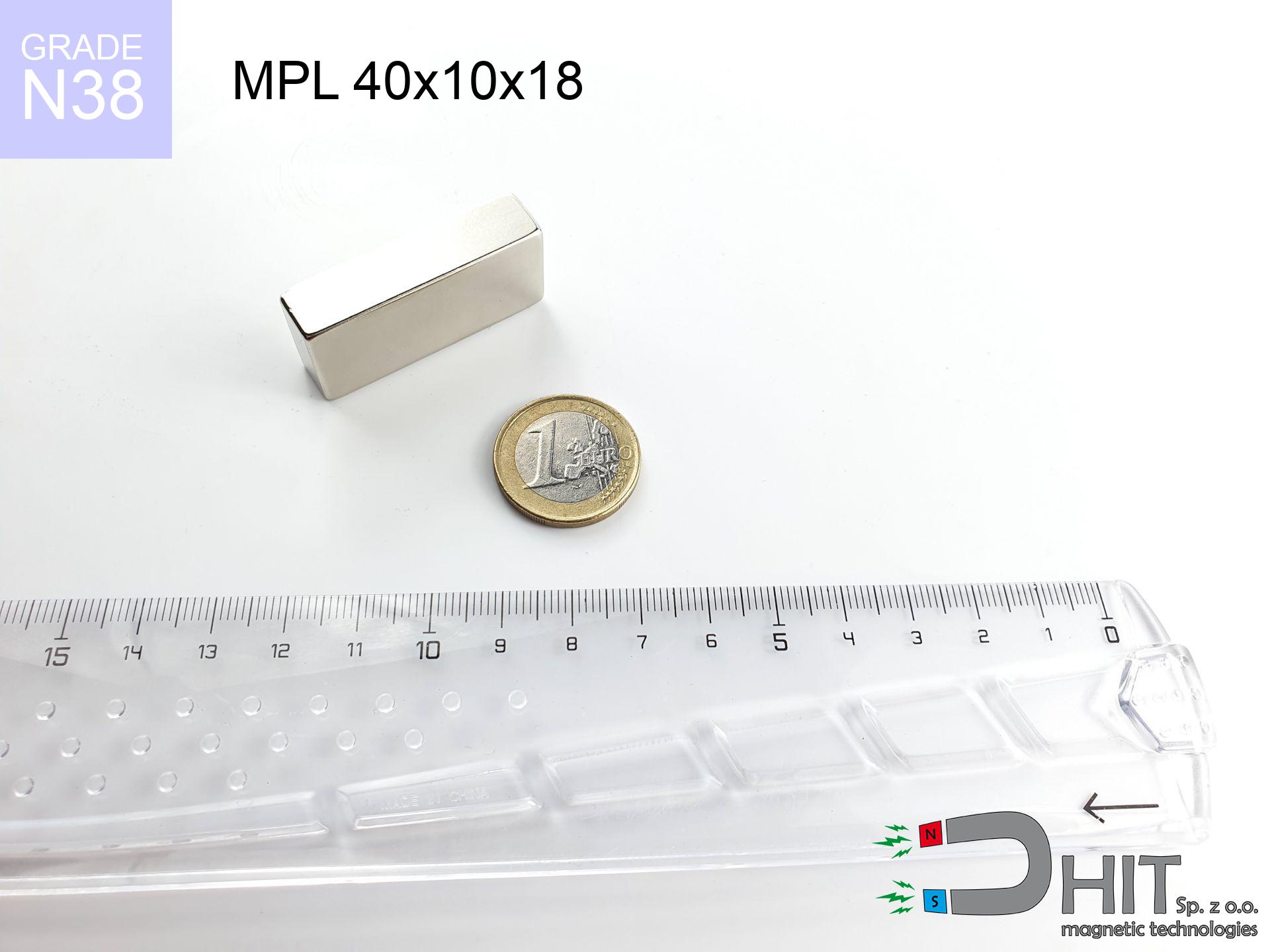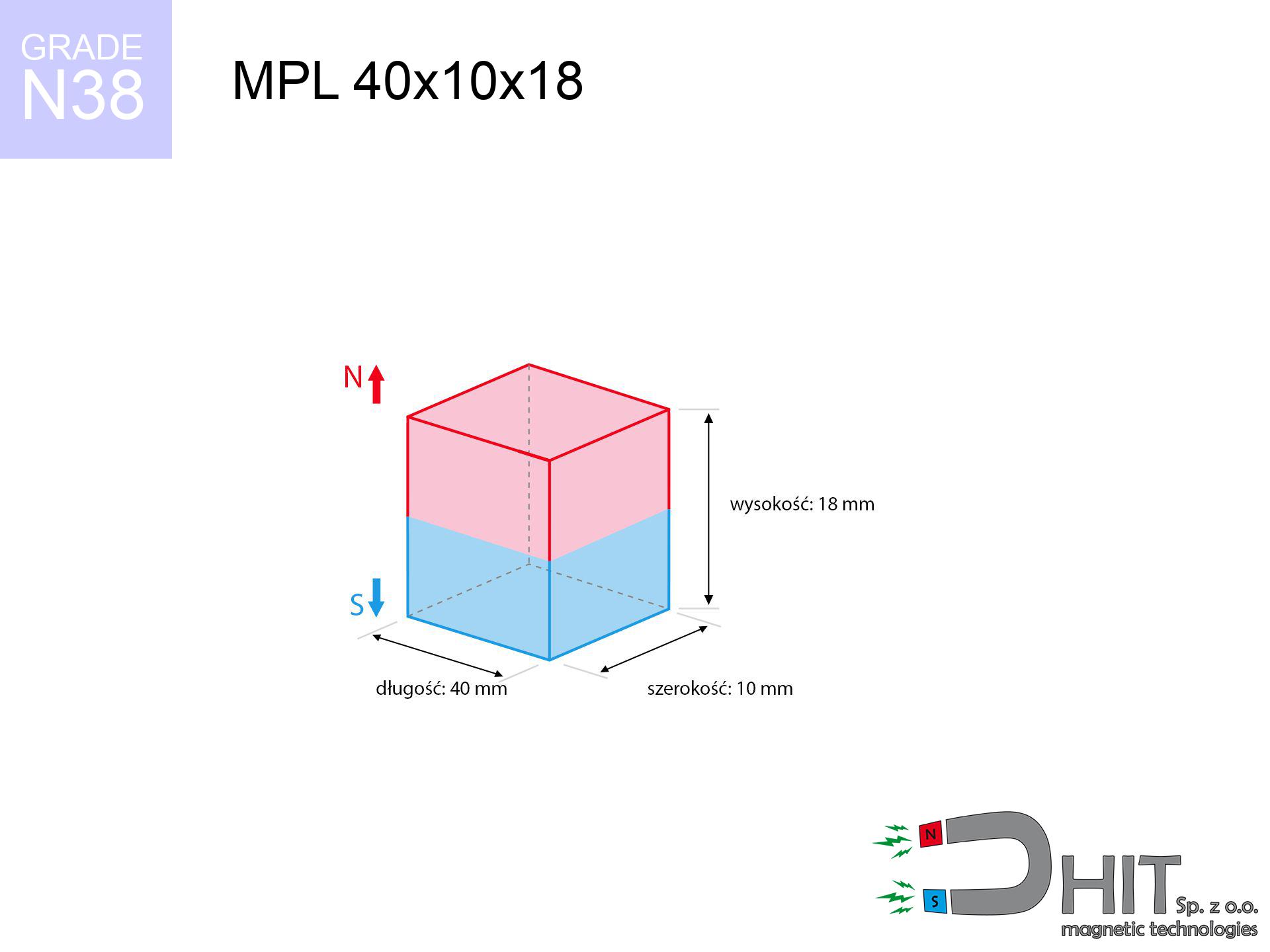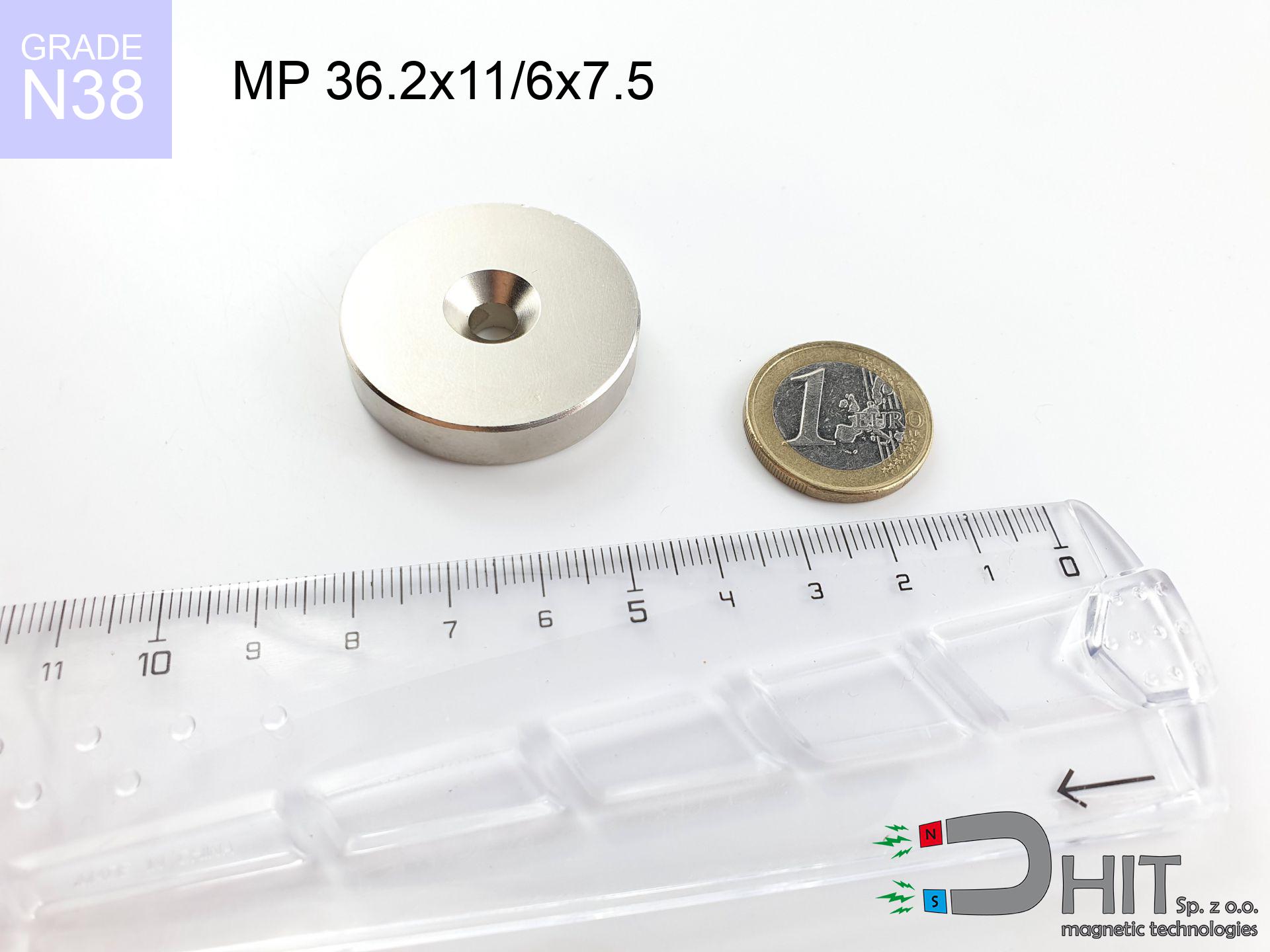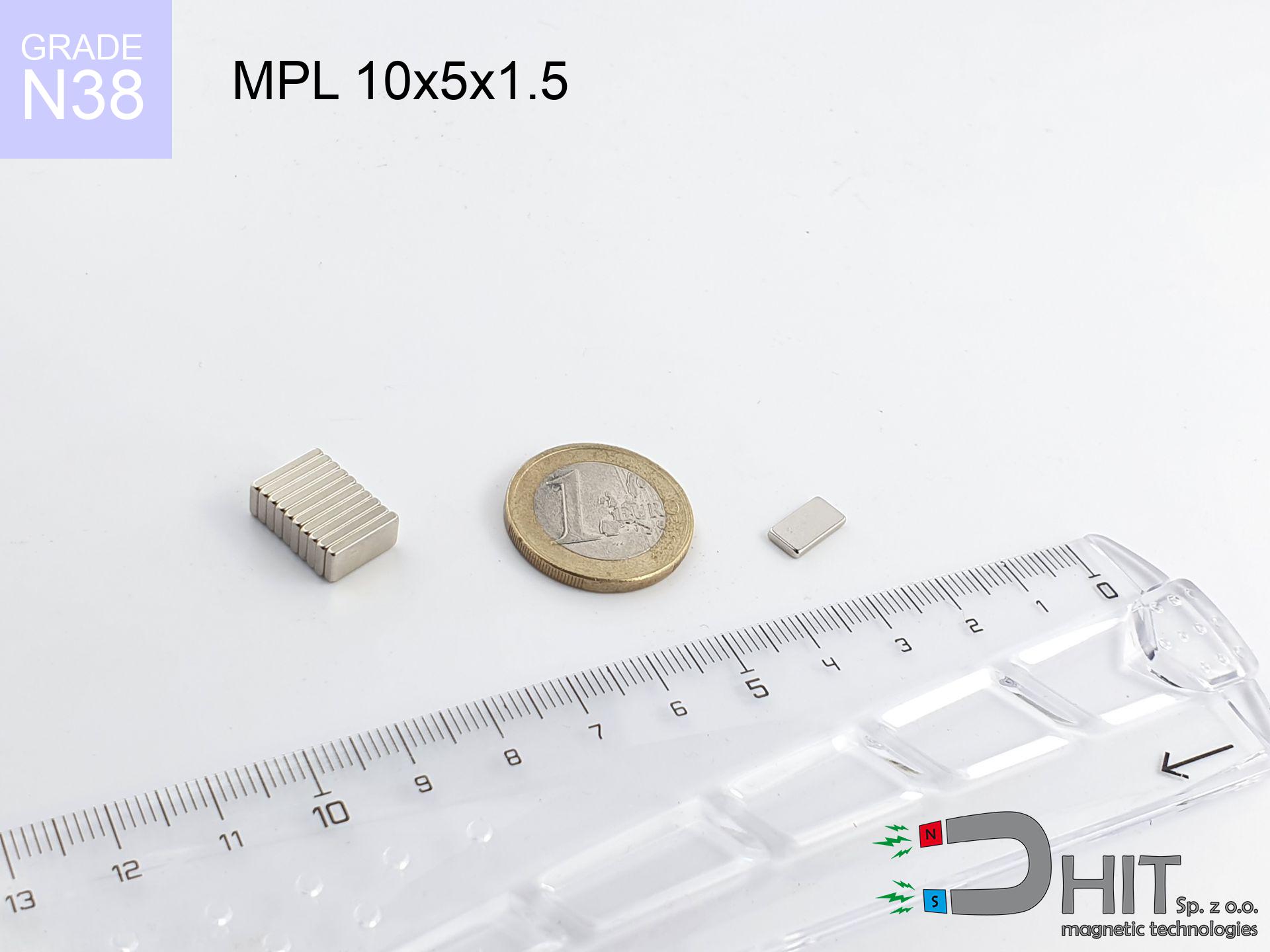MPL 40x10x18 / N38 - lamellar magnet
lamellar magnet
Catalog no 020149
GTIN/EAN: 5906301811558
length
40 mm [±0,1 mm]
Width
10 mm [±0,1 mm]
Height
18 mm [±0,1 mm]
Weight
54 g
Magnetization Direction
→ diametrical
Load capacity
16.72 kg / 164.01 N
Magnetic Induction
540.48 mT / 5405 Gs
Coating
[NiCuNi] Nickel
18.45 ZŁ with VAT / pcs + price for transport
15.00 ZŁ net + 23% VAT / pcs
bulk discounts:
Need more?
Call us now
+48 888 99 98 98
otherwise contact us through
inquiry form
the contact page.
Specifications along with structure of a neodymium magnet can be estimated with our
online calculation tool.
Same-day processing for orders placed before 14:00.
Detailed specification - MPL 40x10x18 / N38 - lamellar magnet
Specification / characteristics - MPL 40x10x18 / N38 - lamellar magnet
| properties | values |
|---|---|
| Cat. no. | 020149 |
| GTIN/EAN | 5906301811558 |
| Production/Distribution | Dhit sp. z o.o. |
| Country of origin | Poland / China / Germany |
| Customs code | 85059029 |
| length | 40 mm [±0,1 mm] |
| Width | 10 mm [±0,1 mm] |
| Height | 18 mm [±0,1 mm] |
| Weight | 54 g |
| Magnetization Direction | → diametrical |
| Load capacity ~ ? | 16.72 kg / 164.01 N |
| Magnetic Induction ~ ? | 540.48 mT / 5405 Gs |
| Coating | [NiCuNi] Nickel |
| Manufacturing Tolerance | ±0.1 mm |
Magnetic properties of material N38
| properties | values | units |
|---|---|---|
| remenance Br [min. - max.] ? | 12.2-12.6 | kGs |
| remenance Br [min. - max.] ? | 1220-1260 | mT |
| coercivity bHc ? | 10.8-11.5 | kOe |
| coercivity bHc ? | 860-915 | kA/m |
| actual internal force iHc | ≥ 12 | kOe |
| actual internal force iHc | ≥ 955 | kA/m |
| energy density [min. - max.] ? | 36-38 | BH max MGOe |
| energy density [min. - max.] ? | 287-303 | BH max KJ/m |
| max. temperature ? | ≤ 80 | °C |
Physical properties of sintered neodymium magnets Nd2Fe14B at 20°C
| properties | values | units |
|---|---|---|
| Vickers hardness | ≥550 | Hv |
| Density | ≥7.4 | g/cm3 |
| Curie Temperature TC | 312 - 380 | °C |
| Curie Temperature TF | 593 - 716 | °F |
| Specific resistance | 150 | μΩ⋅cm |
| Bending strength | 250 | MPa |
| Compressive strength | 1000~1100 | MPa |
| Thermal expansion parallel (∥) to orientation (M) | (3-4) x 10-6 | °C-1 |
| Thermal expansion perpendicular (⊥) to orientation (M) | -(1-3) x 10-6 | °C-1 |
| Young's modulus | 1.7 x 104 | kg/mm² |
Physical simulation of the product - report
The following values are the outcome of a mathematical simulation. Values are based on models for the material Nd2Fe14B. Actual conditions may differ from theoretical values. Treat these calculations as a reference point for designers.
Table 1: Static force (pull vs distance) - interaction chart
MPL 40x10x18 / N38
| Distance (mm) | Induction (Gauss) / mT | Pull Force (kg/lbs/g/N) | Risk Status |
|---|---|---|---|
| 0 mm |
5402 Gs
540.2 mT
|
16.72 kg / 36.86 lbs
16720.0 g / 164.0 N
|
dangerous! |
| 1 mm |
4664 Gs
466.4 mT
|
12.46 kg / 27.48 lbs
12464.6 g / 122.3 N
|
dangerous! |
| 2 mm |
3970 Gs
397.0 mT
|
9.03 kg / 19.90 lbs
9028.7 g / 88.6 N
|
medium risk |
| 3 mm |
3362 Gs
336.2 mT
|
6.48 kg / 14.28 lbs
6476.4 g / 63.5 N
|
medium risk |
| 5 mm |
2432 Gs
243.2 mT
|
3.39 kg / 7.47 lbs
3388.5 g / 33.2 N
|
medium risk |
| 10 mm |
1220 Gs
122.0 mT
|
0.85 kg / 1.88 lbs
853.2 g / 8.4 N
|
low risk |
| 15 mm |
703 Gs
70.3 mT
|
0.28 kg / 0.62 lbs
282.9 g / 2.8 N
|
low risk |
| 20 mm |
440 Gs
44.0 mT
|
0.11 kg / 0.24 lbs
111.1 g / 1.1 N
|
low risk |
| 30 mm |
203 Gs
20.3 mT
|
0.02 kg / 0.05 lbs
23.6 g / 0.2 N
|
low risk |
| 50 mm |
64 Gs
6.4 mT
|
0.00 kg / 0.01 lbs
2.4 g / 0.0 N
|
low risk |
Table 2: Sliding load (vertical surface)
MPL 40x10x18 / N38
| Distance (mm) | Friction coefficient | Pull Force (kg/lbs/g/N) |
|---|---|---|
| 0 mm | Stal (~0.2) |
3.34 kg / 7.37 lbs
3344.0 g / 32.8 N
|
| 1 mm | Stal (~0.2) |
2.49 kg / 5.49 lbs
2492.0 g / 24.4 N
|
| 2 mm | Stal (~0.2) |
1.81 kg / 3.98 lbs
1806.0 g / 17.7 N
|
| 3 mm | Stal (~0.2) |
1.30 kg / 2.86 lbs
1296.0 g / 12.7 N
|
| 5 mm | Stal (~0.2) |
0.68 kg / 1.49 lbs
678.0 g / 6.7 N
|
| 10 mm | Stal (~0.2) |
0.17 kg / 0.37 lbs
170.0 g / 1.7 N
|
| 15 mm | Stal (~0.2) |
0.06 kg / 0.12 lbs
56.0 g / 0.5 N
|
| 20 mm | Stal (~0.2) |
0.02 kg / 0.05 lbs
22.0 g / 0.2 N
|
| 30 mm | Stal (~0.2) |
0.00 kg / 0.01 lbs
4.0 g / 0.0 N
|
| 50 mm | Stal (~0.2) |
0.00 kg / 0.00 lbs
0.0 g / 0.0 N
|
Table 3: Wall mounting (sliding) - behavior on slippery surfaces
MPL 40x10x18 / N38
| Surface type | Friction coefficient / % Mocy | Max load (kg/lbs/g/N) |
|---|---|---|
| Raw steel |
µ = 0.3
30% Nominalnej Siły
|
5.02 kg / 11.06 lbs
5016.0 g / 49.2 N
|
| Painted steel (standard) |
µ = 0.2
20% Nominalnej Siły
|
3.34 kg / 7.37 lbs
3344.0 g / 32.8 N
|
| Oily/slippery steel |
µ = 0.1
10% Nominalnej Siły
|
1.67 kg / 3.69 lbs
1672.0 g / 16.4 N
|
| Magnet with anti-slip rubber |
µ = 0.5
50% Nominalnej Siły
|
8.36 kg / 18.43 lbs
8360.0 g / 82.0 N
|
Table 4: Steel thickness (substrate influence) - sheet metal selection
MPL 40x10x18 / N38
| Steel thickness (mm) | % power | Real pull force (kg/lbs/g/N) |
|---|---|---|
| 0.5 mm |
|
0.84 kg / 1.84 lbs
836.0 g / 8.2 N
|
| 1 mm |
|
2.09 kg / 4.61 lbs
2090.0 g / 20.5 N
|
| 2 mm |
|
4.18 kg / 9.22 lbs
4180.0 g / 41.0 N
|
| 3 mm |
|
6.27 kg / 13.82 lbs
6270.0 g / 61.5 N
|
| 5 mm |
|
10.45 kg / 23.04 lbs
10450.0 g / 102.5 N
|
| 10 mm |
|
16.72 kg / 36.86 lbs
16720.0 g / 164.0 N
|
| 11 mm |
|
16.72 kg / 36.86 lbs
16720.0 g / 164.0 N
|
| 12 mm |
|
16.72 kg / 36.86 lbs
16720.0 g / 164.0 N
|
Table 5: Thermal stability (stability) - power drop
MPL 40x10x18 / N38
| Ambient temp. (°C) | Power loss | Remaining pull (kg/lbs/g/N) | Status |
|---|---|---|---|
| 20 °C | 0.0% |
16.72 kg / 36.86 lbs
16720.0 g / 164.0 N
|
OK |
| 40 °C | -2.2% |
16.35 kg / 36.05 lbs
16352.2 g / 160.4 N
|
OK |
| 60 °C | -4.4% |
15.98 kg / 35.24 lbs
15984.3 g / 156.8 N
|
OK |
| 80 °C | -6.6% |
15.62 kg / 34.43 lbs
15616.5 g / 153.2 N
|
|
| 100 °C | -28.8% |
11.90 kg / 26.25 lbs
11904.6 g / 116.8 N
|
Table 6: Magnet-Magnet interaction (repulsion) - field range
MPL 40x10x18 / N38
| Gap (mm) | Attraction (kg/lbs) (N-S) | Shear Strength (kg/lbs/g/N) | Repulsion (kg/lbs) (N-N) |
|---|---|---|---|
| 0 mm |
71.96 kg / 158.65 lbs
5 928 Gs
|
10.79 kg / 23.80 lbs
10794 g / 105.9 N
|
N/A |
| 1 mm |
62.49 kg / 137.76 lbs
10 068 Gs
|
9.37 kg / 20.66 lbs
9373 g / 91.9 N
|
56.24 kg / 123.98 lbs
~0 Gs
|
| 2 mm |
53.65 kg / 118.27 lbs
9 328 Gs
|
8.05 kg / 17.74 lbs
8047 g / 78.9 N
|
48.28 kg / 106.44 lbs
~0 Gs
|
| 3 mm |
45.76 kg / 100.88 lbs
8 615 Gs
|
6.86 kg / 15.13 lbs
6864 g / 67.3 N
|
41.18 kg / 90.79 lbs
~0 Gs
|
| 5 mm |
32.92 kg / 72.58 lbs
7 308 Gs
|
4.94 kg / 10.89 lbs
4938 g / 48.4 N
|
29.63 kg / 65.32 lbs
~0 Gs
|
| 10 mm |
14.58 kg / 32.15 lbs
4 864 Gs
|
2.19 kg / 4.82 lbs
2188 g / 21.5 N
|
13.13 kg / 28.94 lbs
~0 Gs
|
| 20 mm |
3.67 kg / 8.10 lbs
2 441 Gs
|
0.55 kg / 1.21 lbs
551 g / 5.4 N
|
3.30 kg / 7.29 lbs
~0 Gs
|
| 50 mm |
0.21 kg / 0.46 lbs
585 Gs
|
0.03 kg / 0.07 lbs
32 g / 0.3 N
|
0.19 kg / 0.42 lbs
~0 Gs
|
| 60 mm |
0.10 kg / 0.22 lbs
406 Gs
|
0.02 kg / 0.03 lbs
15 g / 0.1 N
|
0.09 kg / 0.20 lbs
~0 Gs
|
| 70 mm |
0.05 kg / 0.12 lbs
293 Gs
|
0.01 kg / 0.02 lbs
8 g / 0.1 N
|
0.05 kg / 0.10 lbs
~0 Gs
|
| 80 mm |
0.03 kg / 0.06 lbs
217 Gs
|
0.00 kg / 0.01 lbs
4 g / 0.0 N
|
0.03 kg / 0.06 lbs
~0 Gs
|
| 90 mm |
0.02 kg / 0.04 lbs
165 Gs
|
0.00 kg / 0.01 lbs
3 g / 0.0 N
|
0.02 kg / 0.03 lbs
~0 Gs
|
| 100 mm |
0.01 kg / 0.02 lbs
128 Gs
|
0.00 kg / 0.00 lbs
2 g / 0.0 N
|
0.01 kg / 0.02 lbs
~0 Gs
|
Table 7: Protective zones (electronics) - warnings
MPL 40x10x18 / N38
| Object / Device | Limit (Gauss) / mT | Safe distance |
|---|---|---|
| Pacemaker | 5 Gs (0.5 mT) | 13.5 cm |
| Hearing aid | 10 Gs (1.0 mT) | 10.5 cm |
| Mechanical watch | 20 Gs (2.0 mT) | 8.0 cm |
| Mobile device | 40 Gs (4.0 mT) | 6.5 cm |
| Car key | 50 Gs (5.0 mT) | 6.0 cm |
| Payment card | 400 Gs (40.0 mT) | 2.5 cm |
| HDD hard drive | 600 Gs (60.0 mT) | 2.0 cm |
Table 8: Impact energy (cracking risk) - warning
MPL 40x10x18 / N38
| Start from (mm) | Speed (km/h) | Energy (J) | Predicted outcome |
|---|---|---|---|
| 10 mm |
18.30 km/h
(5.08 m/s)
|
0.70 J | |
| 30 mm |
30.76 km/h
(8.55 m/s)
|
1.97 J | |
| 50 mm |
39.69 km/h
(11.02 m/s)
|
3.28 J | |
| 100 mm |
56.12 km/h
(15.59 m/s)
|
6.56 J |
Table 9: Surface protection spec
MPL 40x10x18 / N38
| Technical parameter | Value / Description |
|---|---|
| Coating type | [NiCuNi] Nickel |
| Layer structure | Nickel - Copper - Nickel |
| Layer thickness | 10-20 µm |
| Salt spray test (SST) ? | 24 h |
| Recommended environment | Indoors only (dry) |
Table 10: Electrical data (Pc)
MPL 40x10x18 / N38
| Parameter | Value | SI Unit / Description |
|---|---|---|
| Magnetic Flux | 21 285 Mx | 212.9 µWb |
| Pc Coefficient | 0.79 | High (Stable) |
Table 11: Physics of underwater searching
MPL 40x10x18 / N38
| Environment | Effective steel pull | Effect |
|---|---|---|
| Air (land) | 16.72 kg | Standard |
| Water (riverbed) |
19.14 kg
(+2.42 kg buoyancy gain)
|
+14.5% |
1. Wall mount (shear)
*Note: On a vertical surface, the magnet retains only ~20% of its max power.
2. Steel thickness impact
*Thin metal sheet (e.g. computer case) drastically weakens the holding force.
3. Thermal stability
*For N38 material, the safety limit is 80°C.
4. Demagnetization curve and operating point (B-H)
chart generated for the permeance coefficient Pc (Permeance Coefficient) = 0.79
The chart above illustrates the magnetic characteristics of the material within the second quadrant of the hysteresis loop. The solid red line represents the demagnetization curve (material potential), while the dashed blue line is the load line based on the magnet's geometry. The Pc (Permeance Coefficient), also known as the load line slope, is a dimensionless value that describes the relationship between the magnet's shape and its magnetic stability. The intersection of these two lines (the black dot) is the operating point — it determines the actual magnetic flux density generated by the magnet in this specific configuration. A higher Pc value means the magnet is more 'slender' (tall relative to its area), resulting in a higher operating point and better resistance to irreversible demagnetization caused by external fields or temperature. A value of 0.42 is relatively low (typical for flat magnets), meaning the operating point is closer to the 'knee' of the curve — caution is advised when operating at temperatures near the maximum limit to avoid strength loss.
Material specification
| iron (Fe) | 64% – 68% |
| neodymium (Nd) | 29% – 32% |
| boron (B) | 1.1% – 1.2% |
| dysprosium (Dy) | 0.5% – 2.0% |
| coating (Ni-Cu-Ni) | < 0.05% |
Sustainability
| recyclability (EoL) | 100% |
| recycled raw materials | ~10% (pre-cons) |
| carbon footprint | low / zredukowany |
| waste code (EWC) | 16 02 16 |
See more proposals
Strengths and weaknesses of neodymium magnets.
Benefits
- They retain magnetic properties for nearly 10 years – the loss is just ~1% (based on simulations),
- Magnets very well protect themselves against demagnetization caused by external fields,
- Thanks to the elegant finish, the plating of nickel, gold-plated, or silver gives an visually attractive appearance,
- They show high magnetic induction at the operating surface, which affects their effectiveness,
- Neodymium magnets are characterized by extremely high magnetic induction on the magnet surface and can work (depending on the form) even at a temperature of 230°C or more...
- Possibility of accurate creating as well as adjusting to specific conditions,
- Significant place in modern technologies – they find application in mass storage devices, motor assemblies, medical equipment, and industrial machines.
- Compactness – despite small sizes they generate large force, making them ideal for precision applications
Weaknesses
- Susceptibility to cracking is one of their disadvantages. Upon strong impact they can fracture. We advise keeping them in a steel housing, which not only protects them against impacts but also raises their durability
- Neodymium magnets lose their force under the influence of heating. As soon as 80°C is exceeded, many of them start losing their force. Therefore, we recommend our special magnets marked [AH], which maintain durability even at temperatures up to 230°C
- Due to the susceptibility of magnets to corrosion in a humid environment, we recommend using waterproof magnets made of rubber, plastic or other material stable to moisture, when using outdoors
- Due to limitations in creating nuts and complicated shapes in magnets, we propose using cover - magnetic holder.
- Possible danger to health – tiny shards of magnets pose a threat, when accidentally swallowed, which becomes key in the context of child health protection. Furthermore, tiny parts of these products are able to disrupt the diagnostic process medical after entering the body.
- High unit price – neodymium magnets have a higher price than other types of magnets (e.g. ferrite), which increases costs of application in large quantities
Lifting parameters
Maximum magnetic pulling force – what it depends on?
- with the application of a yoke made of special test steel, ensuring maximum field concentration
- whose thickness reaches at least 10 mm
- with an ground contact surface
- with direct contact (no impurities)
- during detachment in a direction perpendicular to the plane
- at ambient temperature room level
Practical aspects of lifting capacity – factors
- Gap (betwixt the magnet and the metal), because even a very small clearance (e.g. 0.5 mm) can cause a reduction in lifting capacity by up to 50% (this also applies to varnish, rust or debris).
- Angle of force application – maximum parameter is available only during pulling at a 90° angle. The force required to slide of the magnet along the plate is standardly several times smaller (approx. 1/5 of the lifting capacity).
- Base massiveness – insufficiently thick plate causes magnetic saturation, causing part of the power to be escaped to the other side.
- Material type – the best choice is pure iron steel. Cast iron may generate lower lifting capacity.
- Plate texture – smooth surfaces guarantee perfect abutment, which increases field saturation. Rough surfaces weaken the grip.
- Temperature – heating the magnet results in weakening of induction. It is worth remembering the thermal limit for a given model.
Lifting capacity was measured by applying a smooth steel plate of suitable thickness (min. 20 mm), under perpendicular detachment force, whereas under shearing force the holding force is lower. In addition, even a small distance between the magnet and the plate decreases the lifting capacity.
Precautions when working with neodymium magnets
Sensitization to coating
Medical facts indicate that the nickel plating (standard magnet coating) is a strong allergen. If you have an allergy, refrain from direct skin contact and select versions in plastic housing.
Crushing force
Danger of trauma: The pulling power is so immense that it can result in blood blisters, crushing, and even bone fractures. Protective gloves are recommended.
Machining danger
Dust created during cutting of magnets is flammable. Do not drill into magnets unless you are an expert.
Phone sensors
A powerful magnetic field negatively affects the operation of compasses in smartphones and GPS navigation. Maintain magnets close to a device to prevent breaking the sensors.
Fragile material
Despite metallic appearance, the material is delicate and not impact-resistant. Do not hit, as the magnet may crumble into sharp, dangerous pieces.
Life threat
Life threat: Neodymium magnets can deactivate heart devices and defibrillators. Do not approach if you have medical devices.
Keep away from children
These products are not toys. Accidental ingestion of multiple magnets can lead to them pinching intestinal walls, which poses a severe health hazard and requires immediate surgery.
Keep away from computers
Do not bring magnets near a wallet, laptop, or TV. The magnetic field can destroy these devices and erase data from cards.
Respect the power
Handle with care. Rare earth magnets act from a long distance and snap with massive power, often faster than you can react.
Power loss in heat
Control the heat. Heating the magnet to high heat will permanently weaken its magnetic structure and pulling force.




![UMGW 60x30x15 [M10] GW / N38 - magnetic holder internal thread UMGW 60x30x15 [M10] GW / N38 - magnetic holder internal thread](https://cdn3.dhit.pl/graphics/products/umgw-60x30x15-m10-gw-cug.jpg)




